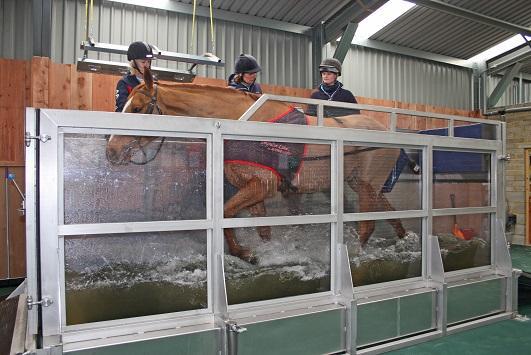Everything you need to know about equine hydrotherapy

Photo: Ray Martin Photography
You might think equine hydrotherapy is just for top competition horses, but an increasing number of amateur riders are incorporating it into their horse’s training programme. It’s a great way to improve fitness and build muscle, and with the eventing season just weeks away, now is a great time to give it a go.
So what exactly is hydrotherapy and how does it work? We spoke to Evonne Armstrong at High Weald Horse Hydro in Sussex to find out…
What’s the difference between swimming and an aqua treadmill?
In my opinion an aqua treadmill is better that swimming. When a horse swims he lifts his neck and nose to stay out of the water, so the shape of the horse is inverted, which puts a strain on their back. On the treadmill, the horses predominantly work in a round outline and lift their stomachs.
When the horse lifts his stomach he engages his core and the hindquarters begin to work, which puts the horse into rear wheel drive. When the power comes from behind, the front lightens and you get the horse off his forehand. This is the frame you are looking for when riding.
Isn’t hydrotherapy just for top competition horses?
No! All horses benefit from time on an aqua tread mill – from riding club horses to happy hackers. They build muscle and fitness, improve circulation and encourage the horse to work correctly.
When you’ve ridden a horse that has worked on an aqua treadmill, and you’ve felt the difference, the therapy sells itself.
You also learn so much about your horse – how often do you get the chance to watch your horse’s back move when he is working? When watching the horse on the treadmill we often pick up on something that validates the way a horse goes with their rider. It’s something they have felt, but not understood, but all of a sudden it makes sense.
How does the treadmill work?
The height of the water targets different muscles groups and the more water we use, the harder they have to work. As we raise the water we slow the belt down, which controls the length of the stride and allows the horse to find his own natural swing and balance.
How do you decide on the depth of the water?
Each horse is individual and will present differently – sometimes they present differently from one day to the next. So while you have an end result that you are working to, you have to read the horse and decide out how well he is working and adapt each session accordingly.
If the horse is finding it too easy or going too fast, we add more water. If the horse is labouring and finding it difficult to keep his balance we take water out, or slow the belt down. Some horses don’t like great deal of water, so we might work them faster.
They are lots of different ways of playing with the machine to get the best results and you don’t need a lot of water for the horse to feel the benefit.
With our machine we use we don’t like to get any deeper than knee/hock and the maximum time is 25mins.
How often does a horse need to use the treadmill for a benefit?
For horses in work I recommend one session a week, to complement their training programme. If a horse is coming for rehab and not being ridden, then two times a week is more effective.
What injuries/problems can hydrotherapy help with?
It can help with broad number of problems, such as tendon and suspensory ligament injuries, degenerative joint disease, kissing spine, sacroiliac joint pain and a range of other back problems.
If a horse is on the treadmill for rehab you need to approach things very carefully, so you don’t make the horse worse by overworking him. You shouldn’t underestimate the power of even a couple of inches of water.
What if a horse is afraid of water, or just won’t go on?
We have a few tricks up our sleeve to get them on, but ultimately it’s down to patience. We go to great lengths to ensure each stage is fully completed and understood by the horse, before we move on to the next. If a horse is scared of water we take our time and for the first few sessions we don’t even put water in.
We’ve only had one failure so far and we will crack her in the end, but it takes an immense amount of time and patience.
For more information visit www.highwealdhorsehydro.co.uk.






